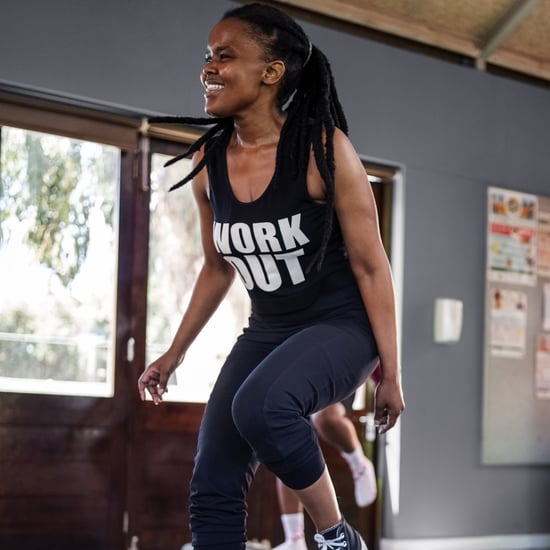How to Make Workouts Harder at Home
Making Your Home Workouts Harder Isn't Just About Adding More Weight — a Trainer Explains
When it comes to getting the most out of your home workout, trainers have given us the following advice: exercise in front of a mirror to keep tabs on your form, focus on your tempo, use follow-along workouts (I like the Peloton app and Class FitSugar videos), set up a space you'll actually want to sweat in, make realistic goals, and find an accountability partner. But what about making those home workouts harder?
Trainer Katie Crewe, CSCS, whom we've interviewed in the past, started out the new year with some crucial tips for people who are exercising at home. Achieving progressive overload — the gradual increase in resistance training in order to effectively build muscle and get stronger — can seem difficult to do outside of the gym. "It doesn't matter which building you're standing in when you're training; you still need to focus on doing more over time to continue to challenge yourself and improve," Katie wrote in her Instagram caption.
Katie said that at home, you often have to apply other methods of progressive overload aside from increasing the weights you're lifting, since that might not be an option for you (not everyone has access to heavy weights). Ahead, check out Katie's tips for how to progress at home. Then, watch her demonstrate them above.
Increase Your Range of Motion
One way to progress your workouts when you're doing bodyweight or light-weighted exercises, Katie wrote in her Instagram caption, is to build strength in a larger range of motion that you can safely control. Then, when you add more of a load, you should be maintaining this form. In her Instagram video, Katie uses the example of a bodyweight Bulgarian split squat. To increase her range of motion, she goes deeper into the split squat with her back leg hovering above the floor and her front leg bending more at the knee.
Increase the Weight That You're Lifting
In the video above, which you'll have to slide through to find the corresponding tip (there's one slide for every tip), Katie does deadlifts with a smaller kettlebell, than switches over to a heavier one. It's pretty self-explanatory, she said, but something still worth noting. Check out how to choose the right weight here.
Increase Your Number of Reps
Katie said that "if a weight becomes too easy for a given number of reps, but you're finding it hard to use the next weight up or there isn't one available," you should increase the number of reps you're doing. This will push you a little bit closer to failure (aka, that point of full muscle exhaustion when you can't do any more reps). In the above video, she uses the example of doing more goblet squats.
Fix Your Form
One way to make exercises more difficult is to check your form. For instance, if you're doing push-ups incorrectly — not going all the way down with your chest to the floor, not extending all the way back up to high plank to finish a rep, etc. — you'll find them to be a lot harder when you make corrections. Here are exercises that will help you work on your push-ups.
Incorporate More Unilateral Exercises
To change it up, you can do single-leg exercises as opposed to moves that use both legs. For instance, try single-leg squats instead of a basic squat or a single-leg Romanian deadlift as opposed to an assisted single-leg Romanian deadlift (with your back foot resting on the ground). "Unilateral training can help you address possible strength imbalances between sides and offers a great bang for your buck in terms of how challenging exercises are with less weight vs their bilateral counterpart," Katie wrote. Here are some single-leg exercises to try.
Choose a More Challenging Exercise Variation
If an exercise becomes too easy — Katie uses the example of doing 45 regular push-ups in a row — try a more challenging form of the exercise if you can. Here are some push-up variations you can choose from. In the video, Katie progresses piked push-ups by elevating her feet on a chair.
Give these tips a try for yourself! Plus, check out these expert tips on how to avoid getting injured during home workouts.






